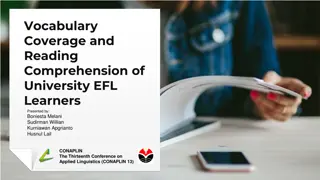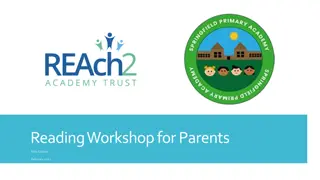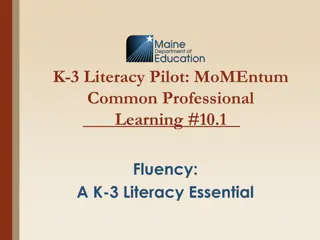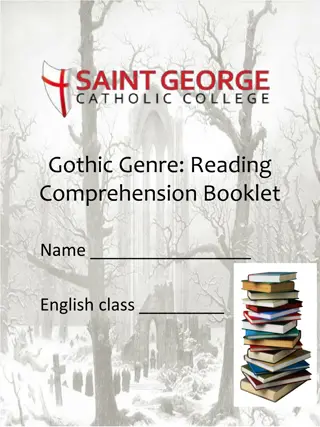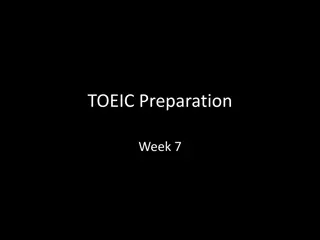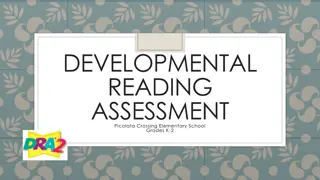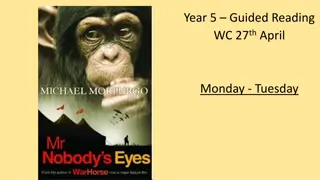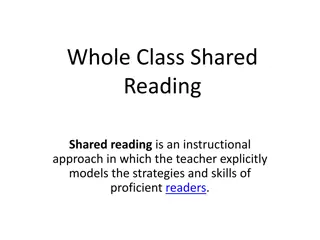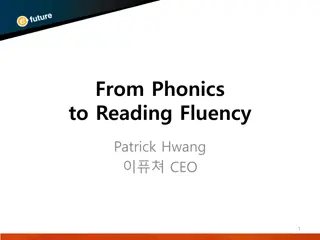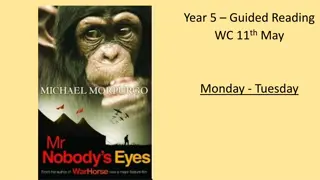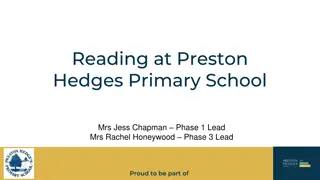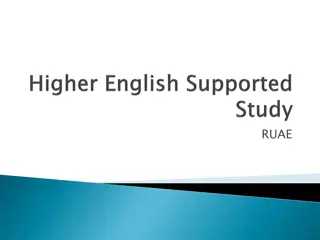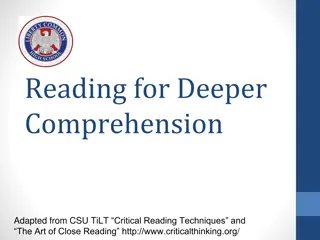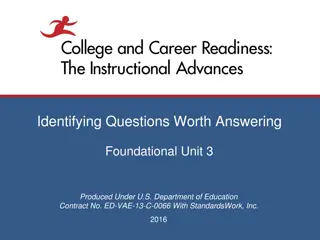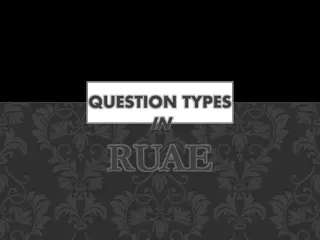Understanding Reading Comprehension: Questions and Strategies
Reading comprehension involves the ability to extract meaning from text through conscious processes before, during, and after reading. Good readers are adept at adjusting their reading based on the difficulty level of the text and utilizing strategies like activating background knowledge, monitoring understanding, making predictions, and summarizing. Reading strategically requires higher-order thinking, such as evaluating, synthesizing, making connections, and problem-solving. Comprehension strategies are intentional plans used to make sense of text and integrate new learning into existing schema. Students need to learn these strategies independently to enhance their reading skills.
Download Presentation

Please find below an Image/Link to download the presentation.
The content on the website is provided AS IS for your information and personal use only. It may not be sold, licensed, or shared on other websites without obtaining consent from the author. Download presentation by click this link. If you encounter any issues during the download, it is possible that the publisher has removed the file from their server.
E N D
Presentation Transcript
READING COMPREHENSION QUESTIONS & STRATEGIES
WHAT IS READING COMPREHENSION? In broad terms, comprehension is the ability of readers to get meaning from text. How does this happen? By asking adult good readers to think aloud as they read, researchers have determined that these readers actively coordinate a number of conscious processes before,during,and after reading (Pressley &Afflerbach,1995).
WHAT IS READING COMPREHENSION? Good readers are aware of how their reading is going and why. They know, for example, when a text is difficult to read because it contains many new ideas and when it is difficult to read because it is poorly written. They are adept at using their prior knowledge as they read to make predictions about what might happen next and to understand ideas as they encounter them (Paris, Wasik, & Turner, 1991).
WHAT IS READING COMPREHENSION? Reading is a highly strategic process during which readers are constantly constructing meaning using a variety of strategies, such as activating background knowledge, monitoring and clarifying, making predictions, drawing inferences, asking questions and summarizing. Strategies are used in combination to solve problems, to think about text and to check understanding. Consequently, teaching comprehension strategies should focus on thinking, problem solving and monitoring understanding.
WHAT IS READING COMPREHENSION? Reading strategically is higher order thinking. It involves transforming information and ideas. For example, summarizing requires evaluating and synthesizing information; making predictions involves combining facts and ideas and making inferences to formulate a type of hypothesis; making connections necessitates making generalizing; and clarifying require identifying problems and developing solutions.
WHAT ARE READING COMPREHENSION STRATEGIES? Comprehension strategies are conscious or intentional plans that people use in order to achieve a goal and are used deliberately to make sense of text. Readers use strategies consciously to make sense of the text, remember critical ideas and integrate new learning into existing schema or prior knowledge. Students need to learn how to use strategies independently, to recognize and solve problems, and to delve deeper into text to make connections and inferences.
GENERAL STRATEGIES FOR READING COMPREHENSION The process of comprehending text begins before children can read, when someone reads a picture book to them. They listen to the words, see the pictures in the book, and may start to associate the words on the page with the words they are hearing and the ideas they represent. In order to learn comprehension strategies, students need modeling, practice, and feedback. The key comprehension strategies are described below.
USING PRIOR KNOWLEDGE/PREVIEWING When students preview text, they tap into what they already know that will help them to understand the text they are about to read. This provides a framework for any new information they read.
PREDICTING When students make predictions about the text they are about to read, it sets up expectations based on their prior knowledge about similar topics. As they read, they may mentally revise their prediction as they gain more information.
IDENTIFYING THE MAIN IDEA AND SUMMARIZATION Identifying the main idea and summarizing requires that students determine what is important and then put it in their own words. Implicit in this process is trying to understand the author s purpose in writing the text.
QUESTIONING Asking and answering questions about text is another strategy that helps students focus on the meaning of text. Teachers can help by modeling both the process of asking good questions and strategies for finding the answers in the text.
VISUALIZING Studies have shown that students who visualize while reading have better recall than those who do not (Pressley, 1977). Readers can take advantage of illustrations that are embedded in the text or create their own mental images or drawings when reading text without illustrations.
MAKING INFERENCES: THE HALLMARK OF GOOD READERS Authors do not always provide complete and explicit descriptions of or information about a topic, a character, a thing, or an event. They do, however, provide clues or suggestions that readers can use to read between the lines, thus allowing the reader to make inferences based on the information in the text and/or on the reader s own background knowledge.
MAKING INFERENCES The ability to make inferences from given information in a text and from background information has been described as the heart of the reading process. In fact, it has been shown that students significantly improve their ability to get meaning from reading when they are taught directly how to draw conclusions and make inferences. Making inferences impacts multiple strategies: activating prior knowledge, making predictions, summarizing, visualizing, clarifying, and asking questions.
THE STRUCTURE OF EXPOSITORY TEXT Expository text is typically structured with visual cues such as headings and subheadings that provide clear cues as to the structure of the information. The first sentence in a paragraph is also typically a topic sentence that clearly states what the paragraph is about. Expository text also often uses one of five common text structures as an organizing principle: Cause and effect Problem and solution Compare and contrast Description Time order (sequence of events, actions, or steps)
TEST -TAKING STRATEGIES FOR READING For students who have enrolled in this class shortly before taking the reading proficiency exam, here are some helpful test-taking strategies you can use: Always read the questions first. This will help you to focus your attention and direct you to the parts of the reading passage that are most important for you to understand.
TEST -TAKING STRATEGIES FOR READING Make sure you understand exactly what each question is asking. STOP and take a moment to think about what you will need to look for in the reading passage. Sometimes it helps to put the question in your own words or circle key words in the passage, such as not, least, cause, effect, first, last, etc. Believe it or not, this is one of the most important strategies for a test taker to learn. If you just read the questions without really thinking about them or taking a moment to circle the most important words in the questions, you will probably forget what the questions are asking before you even finish reading the passage.
TEST -TAKING STRATEGIES FOR READING Do not leave any answers blank! Guess on any of the ones that you do not know. Choose what you think is the best answer by eliminating the choices that do not seem correct. (You can put a tiny pencil mark next to the numbers that you guessed at on your answer sheet and go back to them after you have finished. At the end of the test, you can erase any of these stray pencil marks on your answer sheet before you turn in your paper.
TEST -TAKING STRATEGIES FOR READING Remember that the proficiency test asks you to choose the best answer for each question, so it is important to read all your answer choices and then eliminate the ones that do not seem correct or to best answer the question. (If you are pretty sure that neither letter A nor B is the best answer, then at least you have narrowed down your choices to the 2 remaining two letters: C and D. Now, you have a a fifty percent chance of choosing the most correct answer. Since the Nevada Reading Proficiency Exam usually contains 4 choices for each question, this strategy should help you to get a better score. Even if you can only eliminate one choice, it will still be easier for you to select the best answer from the remaining 3 choices.)
TEST -TAKING STRATEGIES FOR READING Never choose an answer that is not supported by something in the selection or your own background knowledge. Using your background or prior knowledge is crucial to your deciding which answer choices make the most sense. You use your prior knowledge every day of your life. It s so automatic that most of us do not even think about it.
TEST -TAKING STRATEGIES FOR READING If the answer you choose is in the reading passage, make sure that it answers what the question asks. This could be a trick a choice that has information from the passage but does not answer what is being asked. So many times, students think that they are choosing the correct answer just because they read this same sentence in the reading passage. Just because it s in the passage does not mean that it is the correct answer to question you are trying to answer. Many reading tests do this to prevent students from just skimming the passages for the answer and not really reading carefully.
TEST -TAKING STRATEGIES FOR READING Skimming means to glance quickly at a reading passage to get a sense of the topics and important ideas. It should never be used a substitute for careful reading of the passage. However, it can be an important strategy, which you can use throughout the test. Here s an example: A test question asks about the setting of a story. Once you have read the passage all the way through, go back and skip through the paragraphs that discuss other ideas or events. Skim the paragraphs until you find the ones that discuss the time and the place, which together would make up the setting. Now, read this part of the passage carefully.
TEST -TAKING STRATEGIES FOR READING Don t expect to always know the answers to most questions after only one reading. Most test takers expect to read the passage once and then be able to answer the questions. However, very few of us know all of the answers after reading the passage only one time. Good test takers learn how to go back into the passage again and again to find specific information. This is one of the most important strategies for a reading test knowing what information you need and rereading until you find it.
TEST -TAKING STRATEGIES FOR READING If the question says According to the passage or Presented in the passage , make sure that the answer you choose is based on information you read in the passage. This can also be a trick for students who think they can get by without doing the necessary reading. Never choose an answer that contains any wrong information. If any part of an answer choice is wrong, do not choose this answer.
TEST -TAKING STRATEGIES FOR READING Understand that part of an incorrect answer is often correct, but may not be complete enough to be the best answer. You want to make sure that you always choose the most complete and correct answer, especially when you are working on main idea questions.
TEST -TAKING STRATEGIES FOR READING Be aware that the answer to a question is often stated in words that are a little bit different from the exact words used in the reading passage. (This is to test your comprehension, not just word recognition skills. If this were all that s expected of you as a student, you could pass this test in elementary or middle school. ) Here s an example: A passage about the Civil War discusses the casualties of war, but the answer choice uses the word fatalities. By choosing the answer choice that contains the word fatalities, a good test taker is also demonstrating understanding or reading comprehension.
TEST -TAKING STRATEGIES FOR READING About every 10 answers or so, check your answer sheet with your test booklet to make sure that you have been bubbling on the correct lines. If you wait until the end of the test to check over your answer sheet, you could have a problem. So many students do wait until they get to the end of the test to do this. If you have accidentally skipped a line or bubbled in two answers on the same line, you will have quite a mess to clean up. Something like this can affect all the answer choices after your mistake, and you might not erase the wrong answers completely enough. The best thing to do is just make sure this does not happen to you by simply taking a few seconds during the test to check your answer sheet.
TEST -TAKING STRATEGIES FOR READING If you have time after you fish the test, go back and recheck all of your answers in this part of the test. Be sure to check the ones you guessed at first. Then, as suggested earlier, be sure to erase any pencil makes you made on your answer sheet. Believe it or not, this strategy is extremely important for a good test taker. Chances are that if you are like most people, you were a little bit nervous when you went through the test the first time. The pressure is on for you to pass this test in order to get your high school diploma. When we are nervous, we do not always remember things. But once you know that you have already worked hard to read, understand, and bubble in all of the answers, you start to relax just enough to remember certain clue words that were in the passages and what they mean. You also start to remember other strategies you have learned about reading and can put your prior knowledge to work for you.
TEST -TAKING STRATEGIES FOR READING For main idea questions, always reread the first and last sentences. Also, skim through the reading passage to see how many times each of the answer choices is discussed. Here s an example: You are trying to decide whether the main idea is about soccer or football, so you skim through the passage and learn that soccer is mentioned four times. (Be sure to include the pronouns in your count.) However, the writer only mentions football two times. You can be pretty confident that the main idea is about soccer. (If you are given permission to write in your test booklet, go ahead and underline the words football and soccer as you skim. This way, you know you have made the correct choice.)
TEST -TAKING STRATEGIES FOR READING Don t confuse a supporting detail with the main idea. Remember that a supporting detail just explains or gives more information about the topic. Think about the paragraphs you have written in your English classes when your teachers have told you to be sure to write about 8 or 10 sentences that explain about your topic sentence or main idea. When you finish a reading passage, try to sum up everything in one sentence. This should be very close to the main idea. You can do this the same way you would tell a friend about a new movie or song.
TEST -TAKING STRATEGIES FOR READING For time and sequence questions, don t always expect to find all of the events given to you in correct order in the passage. These directions are not in order: Pass up your homework after you sit down. The correct order is first, sit down, and second, pass up your homework. Something like this can fool you on a test. Also, remember to use your clue words for time and sequence like first, then, before, finally, last, etc.
TEST -TAKING STRATEGIES FOR READING For vocabulary questions, when you have to choose the correct meaning of a word, it is helpful to read the following: The sentence that the word is in The sentence right before The sentence right after This area of the passage surrounding the word is called the context. Context clues are the words, phrases, and sentences that surround the word you do not know. Many sentences and paragraphs contain enough information for you to use the clues that the writer has left to figure out the meanings of many words you do not know.
TEST -TAKING STRATEGIES FOR READING For fact and opinion questions: Statements that contain words like good, bad, or great, which show personal values, are opinions: We played a great game against Rancho High School. Statements reporting other people s opinions are facts: The dean said our students are very polite and respectful. The opinion itself is not a fact, but the statement reporting what someone says or believes is a fact. Statements by the writer that something is necessary, or wanted, or liked are opinions: Everyone can enjoy our new menu in the cafeteria. Predictions are opinions: Students would welcome a change in the attendance policy. Facts can always be checked or verified to be either true or false. With a fact, there can be no other reasonable point of view.
TEST -TAKING STRATEGIES FOR READING Multiple choice answers that are often wrong: ./ Answers that seem humorous or ridiculous ./ Answers that contain extreme or absolute statements (all, always, never, no one everyone, impossible, must, absolutely, etc.) ./ Answer choices that are almost exactly alike or say the same thing in different words
TEST -TAKING STRATEGIES FOR READING When you are answering questions that contain the word NOT or EXCEPT, always read though your answer choices carefully. You can answer three of the answers choices with a yes based on what you read in the passage. The one answer choice that you can answer with a no will be the correct answer.
TEST -TAKING STRATEGIES FOR READING Be aware of the three types of questions you will have to answer: Right there questions where the answer can be found right there on the page. Think and search questions where you must look in two or more places for the answer and then make an intelligent guess. On your own questions where you must combine your own background knowledge with the information given in the reading passage.
REMEMBER TO USE YOUR BACKGROUND KNOWLEDGE. TRY TO CONNECT WHAT YOU ARE READING TO WHAT YOU ALREADY KNOW. READ AND THINK .


